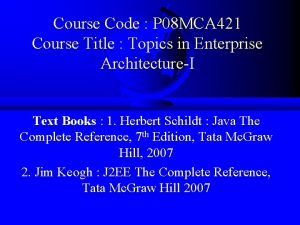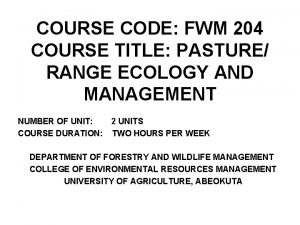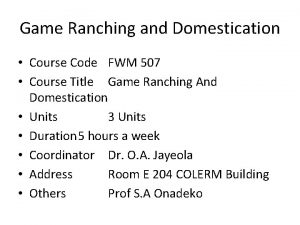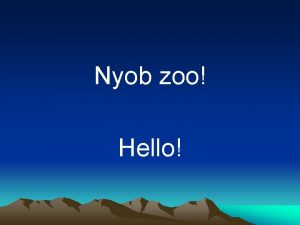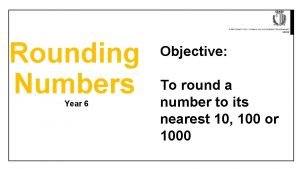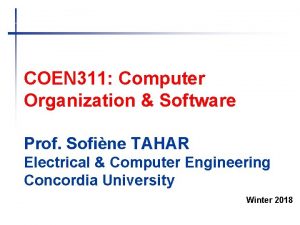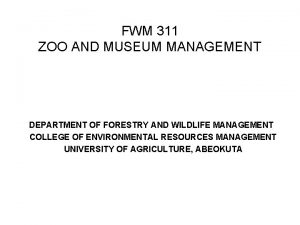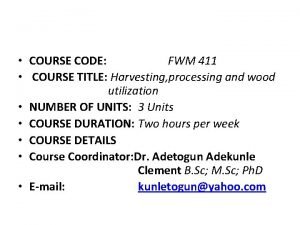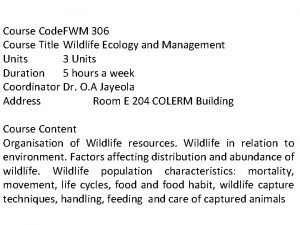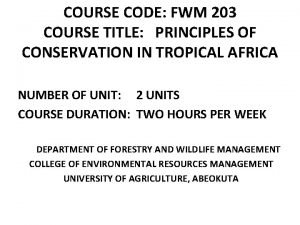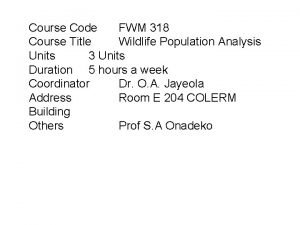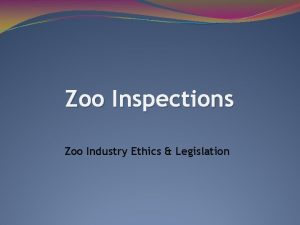COURSE CODE FWM 311 COURSE TITLE ZOO AND


















- Slides: 18

COURSE CODE: FWM 311 COURSE TITLE: ZOO AND MUSEUM MANAGEMENT NUMBER OF UNIT: 2 UNITS COURSE DURATION: TWO HOURS PER WEEK THREE HOURS PER WEEK FOR PRACTICALS DEPARTMENT OF FORESTRY AND WILDLIFE MANAGEMENT COLLEGE OF ENVIRONMENTAL RESOURCES MANAGEMENT UNIVERSITY OF AGRICULTURE, ABEOKUTA

COURSE COODINATOR: DR I. O. O. OSUNSINA E-mail: osunsinaisrael@yahoo. com Office Location: E 211, COLERM OTHER LECTURERS: PROF. S. A ONADEKO

COURSE CONTENT Basic objectives of Zoo and Park Planning. Design of Zoo and Park facilities, capture and transportation of wild animals. Animal health, handling and care of wild animals in captivity. Amusement infrastructures for zoo and nature simulation , feeding of Zoo animals, Zoo sanitation and visitors control. Collection and preservation of animal specimens for educational and recreational purposes.

COURSE REQUIREMENT This is a compulsory course for all students in Department of Forestry and Wildlife Management and Department of Biological Sciences (Zoology option). In view of this, students are expected to participate in all the course activities and have minimum of 75% attendance to be able to write the final examination.

DEFINITION OF ZOOLOGICAL GARDEN • A Zoological garden is a place where wild animals, both native and exotic are kept in cages and paddocks for public viewing. These animals are fed, cured of ailments, and encouraged to breed in captivity

TYPES OF ZOO • Closed • Open • Temporary • Permanent

Designing a zoo • TEMPORAL ZOOS: Temporal zoos are designed to take care of animals for a short period of time. Most of the cages and paddocks are movable (shifting cages). While natural feeds are incorporated in zoo designs, temporal zoos lack most of these settings because it takes quite a substantial amount to undertake such settings. In the same manner, hippopotamus pools, Elephant House, Great Cats House and non-improvised exhibit features are all excluded in temporal zoos for the same reason. The temporariness of a zoological garden set up should never be traded with temporary safety measures or general security of the inmates. In the light of this it is strongly advocated that the temporal zoos be on the same grounds as the intended permanent zoo as the changes will only affect the finances of the garden and not the permanency of the gadgets and buildings.

Designing a zoo • PERMANENT ZOOS • Permanent zoos are those that have facilities to take care of animals on permanent basis. These facilities include buildings (administrative), cages, paddocks, enclosures, sleeping quarters for some animals, gardens, canteens, vet, restraint devices; semi-natural settings, etc. • Exhibition areas, whether indoors or outside, have to be considered broadly in terms of de sign, for as long as the basic requirements of the animals are met and suitable methods for both restraint and viewing are provided, detail of elaboration become architectural devices.

Designing a zoo There are so many designs these days for zoological gardens but the choice of any of the designs is heavily dictated by money available for the project. Especially, a standard zoo is designed with the following in mind. (i) Size and nature of land (ii) Status of the allocated area vis-a-vis the overall master plan for the city/town/institution. (iii) Money available (iv) Behaviour of animals to be exhibited (some animals like the elands require fairly large areas for breeding) (v) Mode of exhibition layout (vi) Future expansion (vii) Natural features already on the site.

DESIGNING ANIMAL DISPLAY In designing the display or exhibition areas, there is always a general movement away from zoo displays with massive bars giving the impression of a prison for animals. • The design factors to be considered include: (a) Safety and health of animals and visitors. (b) Exhibit size and shape. (c) Exhibition orientation - normally the greatest dimension should be parallel with the public.

DESIGNING ANIMAL DISPLAY (d) Orientation of enclosure to avoid glare, excessive sun and rain while getting adequate breeze and ventilation. (e) Materials to be used should be selected for hygiene and ease of maintenance. (f) Eye level of visitors for best viewing, exhibits must be carefully considered including the provision of step ups to assist children and other features. (g) Props and decorations to impart a natural (or artistic) setting. (h) Shift cages to enable animals to be seen and easily moved or treated. (i) Barriers which include cortical wires under tension, bars, rails, moats, fencing, walls, glass, psychological, electrical (shock fences), and thermal (refrigerated coils or hot water lines).

DISPLAY OF ANIMALS Display of animals in a zoo should follow a specific theme; and an ideal zoo should have its theme the general classification of which should include: (a) SYSTEMATIC: Arrangement of exhibits according to their taxonomic or systematic relationship - thus all cats are in one area, all hoofed animals are together, etc. (b) ZOOGEOGRAPHY: The arrangement according to the exhibits geographical origin. For a large zoo this might be African, European, American, Asian; Australian, Eurasian, etc. More appropriate would be a Nigerian theme, or more so a West African or African theme with Sahelian, Savannah, Forest and Riverine or Mountane. Even this may be too large for a beginning and a Rivers State zoo might well initially consist of Forest, Riverine and Ocean exhibits. (c ) HABITAT OR ECOLOGICAL: These tend to be specialist displays of animals. An aquarium is a popular form of this theme which is appropriate for a state like Rivers. An ocean shore tank which generates artificial waves would be particularly interesting.

DISPLAY OF ANIMALS (d ) BEHAVIOURAL: This theme has a considerable potential. A typical - although rather expensive - theme is a nocturnal animal display which has special lighting which enables animals only active at night to be exhibited in day time. (e )“POPULAR”: In which animals are selected and presented on the basis of popular appeal (f ) MIXTURE: All the above should be used with discretion and some mixing of themes will usually be advisable.

LAYOUT OF OTHER AMENITIES IN A ZOO Features not specifically related to the display of animals in a zoo layout but highly essential in the layout of any permanent zoo. (i) Adequate parking facilities. (ii) Entrances and exits which should be limited but able to cope with peak periods.

LAYOUT OF OTHER AMENITIES IN A ZOO (iii) Landscaping with proper horticultural treatment to make the zoo an attractive habitat and not a prison for animals. (iv) Sculpture: Zoos are ideal settings for sculpture gardens; especially sculptures of animals which cannot be exhibited because they are extinct or too difficult for the zoo to keep.

LAYOUT OF OTHER AMENITIES IN A ZOO (v) Public Amenities: These range from adequate and clean toilets and refreshment kiosks to hotel accommodation, amusement parks, etc. They should also relate to the appropriate formsof building design and construction as visitors may be intrigued by the human artefacts for a region as the animals.

LAYOUT OF OTHER AMENITIES IN A ZOO (vi) Method of Circulation: By footpaths, bridges, railways etc; with adequate places for resting. Gentle ramps should be used in preference to steps and loose surface such as gravels which can be used as missiles by the public (children) should be avoided. (vii) Administrative offices, animal hospitals, research laboratories, maintenance workshop, etc

GENERAL SECURITY OF ZOO The general security of any zoo covers both the sensitive and non-sensitive areas of the zoo. (i) Fencing; (ii) Secure animal cages; (iii) Cold rooms and all food stores; (iv) Visitor safety; (v) Animal safety from public feeding etc; (vi) Safety of other buildings and structures. (Vii) FENCING: Fencing of the perimeter must be adequate to keep animals and unauthorized persons from getting in or out.
 Fwm 421
Fwm 421 Fwm 421
Fwm 421 Domestication
Domestication Nyob zoo sawv ntxov
Nyob zoo sawv ntxov Course number and title
Course number and title Busceral
Busceral Prefatory elements
Prefatory elements Title title
Title title Uw cse 312
Uw cse 312 Tutela provisória art 294 a 311
Tutela provisória art 294 a 311 Csci 311
Csci 311 Ist 311
Ist 311 311 rounded to the nearest ten
311 rounded to the nearest ten Psyc 311
Psyc 311 Rtca do-311
Rtca do-311 Rpv311
Rpv311 Coen311
Coen311 The number 311-38 is divisible by prime numbers:
The number 311-38 is divisible by prime numbers: The number 311-38 is divisible by prime numbers:
The number 311-38 is divisible by prime numbers:
